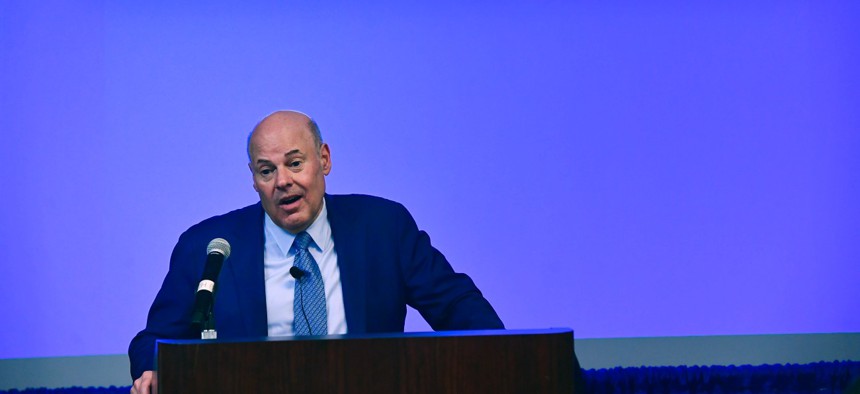
When Louis DeJoy first took office, the postmaster general led an effort to slash tens of thousands of non-union jobs by offering early retirement incentives and layoffs as part of a reorganization of its management structure. Helen H. Richardson/MediaNews Group/The Denver Post via Getty Images
USPS Plans to Slash 50,000 Positions in Coming Years to Reach 'Break Even' Point
The plan envisions relying solely on attrition. Meanwhile, USPS is delivering election ballots at a much faster clip.
The U.S. Postal Service is planning to shed 50,000 positions from its rolls over the next several years as part of Postmaster General Louis DeJoy’s plan to cut the agency’s financial losses, though it will rely on natural attrition to make the cuts.
USPS will remain in a hiring posture in the coming years, DeJoy said at an American Enterprise Institute event in Washington on Wednesday evening, as the net reductions represent only one-quarter of the attrition the agency expects to see over a similar period. The postmaster general had not previously outlined his final vision for the impact his 10-year business plan would have on the size of the workforce, speculating last year he might spearhead a net growth.
“Right now, to get to break even, I think we may need to get 50,000 people out of the organization,” DeJoy said. "But that's OK, because over the next two years, 200,000 people [will] leave the organization for retirement.”
The reduction would reverse a trend in recent years in which the USPS workforce has remained steady or grown slightly. The Postal Service ended 2021 with nearly 517,000 career employees, its highest total since 2012. The non-career workforce has remained fairly steady in recent years at 136,000. Part of the growth was due to a concerted effort under DeJoy to convert tens of thousands of non-career workers, who earn less money and fewer benefits, into career roles to reduce the high rates of attrition USPS has experienced. The agency has cut more than 200,000 positions since its peak around the turn of the century, but the total has largely stabilized in recent years.
When DeJoy first took office, the postmaster general led an effort to slash tens of thousands of non-union jobs by offering early retirement incentives and layoffs as part of a reorganization of its management structure. He subsequently said he might have to add 100,000 employees to support the Postal Service’s growing package business.
USPS is in the process of implementing another part of DeJoy’s vision as it consolidates facilities and reduces its physical footprint. He pledged to get rid of 150 annex plants and the agency is in the process of building mega-centers that he said will reduce redundant operations and transportation. Outside of the annexes, DeJoy said he does not envision mass closures, but instead reshaping the network so each piece of mail flows in a more logical fashion and does not have to take as many trips before reaching its final destination.
Elections
As it implements these changes, the Postal Service is also gearing up for its role in the 2022 midterms. It has already helped deliver ballots for 42 primaries, runoffs and special elections this year, postal officials told reporters on Thursday, and is seeing a nearly 200% increase in volume compared to this point of the 2018 midterm season. It has delivered 99.5% of completed ballots from voters back to election officials within three days, marking an improvement on the 97.9% rate it oversaw in 2020. Ballots are taking 1.8 days on average to go from election officials to voters, and 0.7 days to from the voters back to the officials.
As part of a settlement agreement with the NAACP and Public Citizen last year, USPS pledged to make a “good-faith effort” to implement “extraordinary measures” in the runup to the election similar to those in place in 2020. The Postal Service will begin carrying out extra deliveries and collections, special pickups and expanded processing facility hours on Oct. 24 and continue those steps through Nov. 29, said Adrienne Marshall, USPS’ first-ever Election and Government Mail Services director.
The Postal Service sent kits to election officials across the country in March to offer their recommendations for election mail policies and has maintained “strike teams” at the area and district levels to engage with those individuals.
While many states and jurisdictions have sought to place restrictions on mail-in voting, often citing false claims of voter fraud, DeJoy sought to quash any reservations about the system.
“I know election mail is safe,” he said. “And it'll continue to be safe because we pay a lot of attention to it.”
NEXT STORY: GovExec Daily: Schedule F Might Be Coming Back







